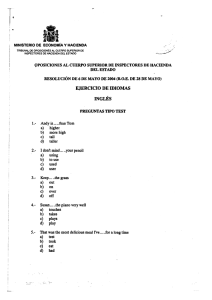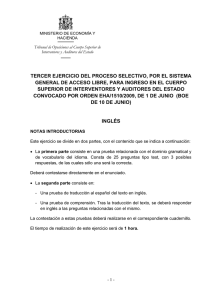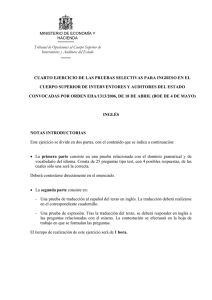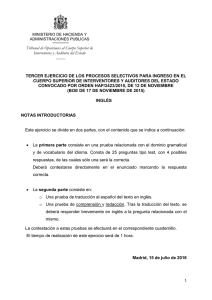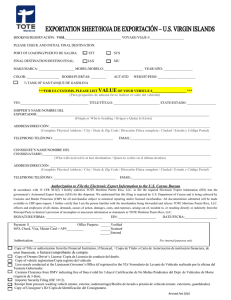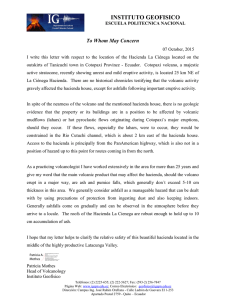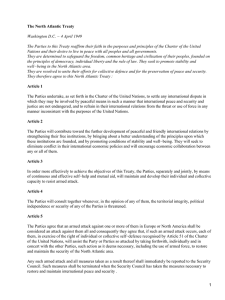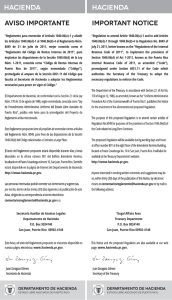oposición al cuerpo superior de inspectores de hacienda del estado
Anuncio
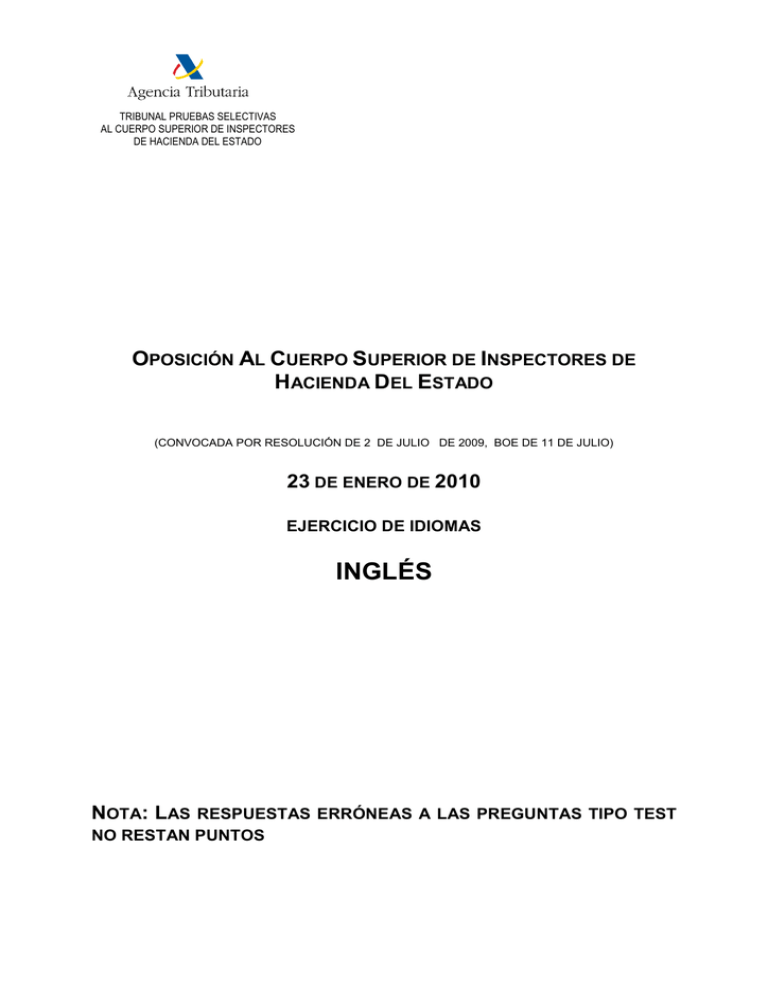
TRIBUNAL PRUEBAS SELECTIVAS AL CUERPO SUPERIOR DE INSPECTORES DE HACIENDA DEL ESTADO OPOSICIÓN AL CUERPO SUPERIOR DE INSPECTORES DE HACIENDA DEL ESTADO (CONVOCADA POR RESOLUCIÓN DE 2 DE JULIO DE 2009, BOE DE 11 DE JULIO) 23 DE ENERO DE 2010 EJERCICIO DE IDIOMAS INGLÉS NOTA: LAS RESPUESTAS ERRÓNEAS A LAS PREGUNTAS TIPO TEST NO RESTAN PUNTOS TRIBUNAL PRUEBAS SELECTIVAS AL CUERPO SUPERIOR DE INSPECTORES DE HACIENDA DEL ESTADO 1. Didn’t you know that NATO ...................... for North American Atlantic Treaty? a) b) c) d) fits rises stands matches 2. I detest ........................... in cold water a) b) c) d) have a swim swimming to swim to swimming 3. He was a friend of mine at school. I wonder if he ........................ to get a first class degree. a) b) c) d) made got managed provided 4. If I had won the big prize in the lottery I ..................... a new car. a) b) c) d) will bought would have bought buy had bought 5. He feels ...................... for sleeping while she is working so hard a) b) c) d) worry guilty pointless tired 1 TRIBUNAL PRUEBAS SELECTIVAS AL CUERPO SUPERIOR DE INSPECTORES DE HACIENDA DEL ESTADO 6. Have you ever visited London? Yes, I have ................. to London four times last year a) b) c) d) gone staying moved been 7. We work very .................. hours, but we do not earn a lot of money a) b) c) d) large wide long over 8. He earns a ............... as a teacher at the High School. a) b) c) d) living cost job attaining 9. Thefts at the library have been ......................... as high as fifty a year a) b) c) d) made stood dropped put 10. They were accused …………………... smuggling when they crossed the border. a) b) c) d) on of about under 2 TRIBUNAL PRUEBAS SELECTIVAS AL CUERPO SUPERIOR DE INSPECTORES DE HACIENDA DEL ESTADO 11. I am going to look for .......................... beer in the fridge a) b) c) d) some of any some any of 12. It was a lovely weekend. I have happy ......................... of the journey. a) b) c) d) regard remenbers memories remembering 13. My father has been living in France .......................... ten years a) b) c) d) for since long as ago 14. You run ............. than me a) b) c) d) quickly more quickly quick so quickly 15. This report is very interesting. It is worth ...................... a) b) c) d) read reading to read to reading 16. In my opinion the new regulation ................................. by Parliament tomorrow. a) b) c) d) would pass is passed will be passed is going passed 3 TRIBUNAL PRUEBAS SELECTIVAS AL CUERPO SUPERIOR DE INSPECTORES DE HACIENDA DEL ESTADO 17. He is very tired because ………………… from 5:00 a.m. a) b) c) d) queued had being queued has been queued would queue 18. The compliance of the law is ……………………….for everybody. a) b) c) d) compulsory regulatory regarding involving 19. This subject is a key priority. It is becoming ............................. important for everybody. a) b) c) d) hardly valuable increasingly priceable 20. We are going to ……………… a meeting about the impact of the training seminars. a) b) c) d) make install look for hold 21. It is useless to .......................... good news from him a) b) c) d) meet keep wide hope 4 TRIBUNAL PRUEBAS SELECTIVAS AL CUERPO SUPERIOR DE INSPECTORES DE HACIENDA DEL ESTADO 22. When arriving to the airport, you have to look for two .............................. reading the same book. a) b) c) d) person people peoples persons 23. If you did not pass this examination you …………………… drive your own car a) b) c) d) will not did not do not would not 24. After this experience, I was ...................... to admit that not everyone is born to be an artist. a) b) c) d) denied charged forced argued 25. I could not believe it, but the plane took off .......... time. a) b) c) d) at on by over 26. I am expecting they send me a new e-mail regarding the project and a file .............. a) b) c) d) joined attached suspended written down 5 TRIBUNAL PRUEBAS SELECTIVAS AL CUERPO SUPERIOR DE INSPECTORES DE HACIENDA DEL ESTADO 27. We have not devoted to this subject the attention .................... a) b) c) d) required assisted stood attended 28. Now you are in a trial, you must ……………… the truth to the Court. a) b) c) d) say talk tell speak 29. Please, shut up, do not .......................... me laugh. a) b) c) d) get make do keep 30. I have displayed the current initiatives that we are ....................... nowadays. a) b) c) d) implementing implemented having implemented had implemented 6 TRIBUNAL PRUEBAS SELECTIVAS AL CUERPO SUPERIOR DE INSPECTORES DE HACIENDA DEL ESTADO A CONSTITUTION FOR EUROPE CONSTITUTIONAL PROCESS On 29 October 2004, the Treaty establishing a Constitution for Europe was signed in Rome by the 25 Heads of State and Government. The Constitution represents the completion of a long process of integration marked by ever closer integration and by the successive enlargements of the Union. It was the first European Parliament to be elected by universal suffrage which really launched the debate on the constitutionalisation of Europe. On 14 February 1984 it adopted by a large majority Altiero Spinelli's report proposing, in a "draft treaty on European Union", a fundamental reform of the European Community. Since then, the succeeding treaties have brought progress in the building of Europe, through the following innovations: The first step was taken in 1987 with the signing of the Single European Act , the first reform of the treaties since the 1950s. The objective of this Treaty was to complete the single market by 1992. In 1992 the Treaty on European Union (EU Treaty) signed in Maastricht saw the start of a new development; it established the European Union and introduced a common foreign and security policy (CFSP) as well as cooperation in the field of justice and home affairs (JHA). 7 TRIBUNAL PRUEBAS SELECTIVAS AL CUERPO SUPERIOR DE INSPECTORES DE HACIENDA DEL ESTADO With this major step, Europe thus embarked upon its transformation from an economic community to a political union. This reform also opened the door to economic and monetary union and the euro. The Treaty of Amsterdam signed in 1997 intensified European integration, particularly by formally establishing the principles of freedom, democracy and respect for human rights, creating a basis for a common policy on freedom, security and justice and adding new domains to the Community scope. It also paved the way for a reform of the European institutions, in particular with a view to enhancing the role of the European Parliament. This reform of the institutions, necessary in the run-up to the biggest enlargement in the history of the Union to embrace the countries of eastern Europe, was fleshed out by the Treaty of Nice signed in 2001. The European Constitution was conceived as the continuation of the process of institutional reforms initiated by the Treaty of Nice. BIRTH OF THE CONSTITUTION Once the Treaty of Nice was signed, the body of Community law as a whole was based on eight treaties and more than 50 protocols and annexes. The treaties mentioned above did not just amend the original EC Treaty, but also produced further texts which were combined with it. The combination of these various treaties made the European structure more and more complex and very difficult for European citizens to comprehend. The Treaty of Nice, the technical adaptations in which did little to clarify the situation, opened the door for a process of institutional reform which had become essential. The declaration on the future of the European Union annexed to the Final Act of the 2000 Inter-Governmental Conference (IGC) mapped out the route towards a new 8 TRIBUNAL PRUEBAS SELECTIVAS AL CUERPO SUPERIOR DE INSPECTORES DE HACIENDA DEL ESTADO reforming treaty. It was on the basis of this declaration that the move towards the Constitution took on a concrete form. At its meeting in Laeken in December 2001, the European Council established the European Convention to prepare the reform and make proposals. The choice of a Convention represented a significant departure from previous treaty revision procedures, reflecting the desire to do away with meetings of government leaders held behind closed doors. STRUCTURE OF THE CONSTITUTIONAL TREATY The Constitutional Treaty is divided into four main parts, which are all of equal rank. Following a constitution-style Preamble recalling the history and heritage of Europe and its determination to transcend its divisions, Part I is devoted to the principles, objectives and institutional provisions governing the new European Union, divided into nine Titles. Part II of the Constitutional Treaty comprises the European Charter of Fundamental Rights. It contains seven Titles, preceded by a Preamble. Part III comprises the provisions governing the policies and functioning of the Union. The internal and external policies of the Union are laid down, including provisions on the internal market, economic and monetary union, the area of freedom, security and justice, the common foreign and security policy (CFSP), and the functioning of the institutions. Part III also contains seven Titles. Part IV groups together the general and final provisions of the Constitution, including entry into force, the procedure for revising the Constitution and the repeal of earlier Treaties. A certain number of protocols have been annexed to the Treaty establishing the Constitution. 9 TRIBUNAL PRUEBAS SELECTIVAS AL CUERPO SUPERIOR DE INSPECTORES DE HACIENDA DEL ESTADO In addition, a large number of declarations have been annexed to the Final Act of the IGC. MAIN ACHIEVEMENTS In the interests of clarity, the main innovations in the Constitutional Treaty have been grouped together in four chapters, as summarised below. Decision-making A new qualified majority system is established, under which 55% of the Member States representing 65% of the population will constitute a qualified majority. Qualified majority voting in the Council of Ministers is being extended to cover around 20 existing and 20 new legal bases. The joint adoption of European laws and framework laws by the European Parliament and the Council is to become the norm (ordinary legislative procedure ). Several bridging clauses are created for facilitating subsequent extensions of qualified majority voting and switchover to the ordinary legislative procedure. Union policies Economic coordination between the countries that have adopted the euro is to be improved, and the informal role of the Euro Group is to be recognised. The pillar structure is abolished. The second (common foreign and security policy) and third (justice and home affairs) pillars, which were hitherto subject to the intergovernmental method, are brought within the Community framework. The common foreign and security policy is strengthened with the creation of a European Minister for Foreign Affairs and the progressive definition of a common defence policy through, for example, the creation of a European Defence Agency and the authorisation of enhanced cooperation in this field. 10 TRIBUNAL PRUEBAS SELECTIVAS AL CUERPO SUPERIOR DE INSPECTORES DE HACIENDA DEL ESTADO A genuine area of freedom, security and justice is to be created through the planned implementation of common policies on asylum, immigration and external border control, in the field of judicial and police cooperation, and through the development of Europol and Eurojust actions and the creation of a European Public Prosecutor's Office. RATIFICATION: THE FINAL STEP To enter into force, the Treaty establishing a Constitution for Europe had to be ratified by all the Member States in accordance with each one's constitutional rules, namely either parliamentary ratification or referendum. According to the Constitution, the ratification process was expected to last for two years, and the Constitution was due to enter into force no later than 1 November 2006. Following the ratification problems encountered in certain Member States, the Heads of State and Government decided at the European Council of 16 and 17 June 2005 to launch a "period of reflection" on the future of Europe. The idea was to initiate a broad debate with European citizens. At the European Council meeting on 21 and 22 June 2007, European leaders reached a compromise and agreed to convene an IGC to finalise and adopt, not a Constitution, but a reform treaty for the European Union. The final text of the treaty, drawn up by the IGC, was approved at the informal European Council in Lisbon on 18 and 19 October. The Treaty of Lisbon was signed by the Member States on 13 December 2007. 11
